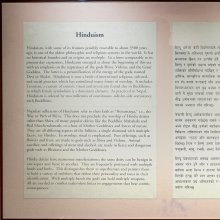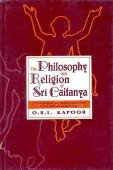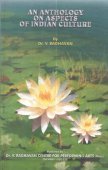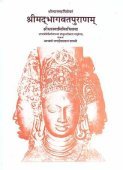Bhakti, Bhaktī: 40 definitions
Introduction:
Bhakti means something in Hinduism, Sanskrit, Jainism, Prakrit, the history of ancient India, Marathi, Hindi. If you want to know the exact meaning, history, etymology or English translation of this term then check out the descriptions on this page. Add your comment or reference to a book if you want to contribute to this summary article.
Images (photo gallery)
In Hinduism
Purana and Itihasa (epic history)
Source: archive.org: Puranic EncyclopediaBhakti (भक्ति).—A Devī born in Drāviḍa deśa (Southern India). Once Devī, along with her two sons, Jñāna and Vairāgya, started on a walking tour to Gokula and Vṛndāvana via Karṇāṭaka, Mahārāṣṭra and Gurjara (Gujarat). During the long tour the mother and her sons became aged. But, as soon as they set foot on Gokula and Vṛndāvana old age quitted Bhakti and she became young again. But, her sons remained old. So the mother requested Nārada to turn them young again. Nārada read out to them the Vedas, the Vedānta (Upaniṣads) and the Bhagavad Gītā, all to no purpose. Bhakti’s sons still remained old. Then Sanaka, Sananda and Sanatkumāra asked Nārada to read out the Bhāgavata to them. Nārada did so, and the sons of Bhaktī Devī became young again. (Padma Purāṇa).
Source: archive.org: Nilamata Purana: a cultural and literary studyBhakti (भक्ति) refers to one of the various systems of belief and worship that once existed in ancient Kashmir (Kaśmīra) as mentioned in the Nīlamatapurāṇa.—As regards the cult of Bhakti, the Nīlamata introduces personal deities who are always ready to help their worshippers. The devotee surrenders himself wholly to the hands of God Who destroys his sufferings. Vāsuki, Kaśyapa, Nīla, Paraśurāma, all approach Viṣṇu as humble devotees and get the fulfilment of their desires. Śiva himself goes to Kālodaka lake to endow Nandī with a boon. The Nāga deity Nīla is described as compassionate for the devotees and performer of their deeds. The only condition is that the worshipper must approach the deity with true devotion and feeling of submission. One thing notable is that the devotion in the Nīlamata does not contain the erotic element.
Source: archive.org: Shiva Purana - English Translation1) Bhakti (भक्ति) refers to “devotion” which is considered the root of “true knowledge” (vijñāna), according to the Śivapurāṇa 2.1.12, while explaining details of worship:—“[...] the root of true knowledge (vijñāna) is unswerving devotion (bhakti). The root of knowledge (jñāna) too is devotion. The root of devotion is good action and the worship of one’s own favourite deity. The root of that is the good preceptor. A good preceptor is secured only through association with good people”.
2) Bhakti (भक्ति) refers to the “(nine-fold) devotion”, as explained in the Śivapurāṇa 2.2.23, as Śiva said to Satī:—“[...] O Goddess Satī, listen, I shall explain the great principle whereby the remorseful creature becomes a liberated soul (mukta). [...] Devotion (bhakti) to me is considered as the bestower of worldly pleasures and salvation. It is achievable only by my grace. It is nine-fold (navadhā). There is no difference between devotion and perfect knowledge. A person who is engrossed in devotion enjoys perpetual happiness. Perfect knowledge never descends in a vicious person averse to devotion”.
The nine ancillary adjuncts (navāṅga) [of devotion] are:
- listening (śravaṇa),
- eulogising (kīrtana),
- remembering (smaraṇa),
- serving (sevana),
- surrendering, (dāsya)
- worshipping (arcana),
- saluting (vandana),
- friendliness (sakhya),
- dedication (arpaṇa).
Bhakti (भक्ति).—Selfless devotion; leads one to self-realisation; methods and results of; destroys rajas and tamas qualities; roots out sorrow, illusion and fear; redeems the sinners;1 superior to karma;2 one of the five means of concentrating the mind on Hari, (i.e.) (1) kāma as in the case of the Gopis; (2) fear and hatred as in the case of Kaṃsa and Śiśupāla; (3) relationship as in the case of the Vṛṣṇis; (4) friendship as in the case of Yudhiṣṭhira and (5) devotion as in the case of Nārada; vena does not come under any of these heads;3 but nine-fold according to Prahlāda: hearing of Hari, praising of, remembering, serving His holy feet, arcana, prostrating, service, friendship and surrender of self;4 women more devout than men.5 Three-fold—uttama as that of Nārada and Śuka: middling as that of Vasiṣṭha, and inferior;6 another classification: three-fold, śāṅkhya, yoga, and jñāna; a pure man can meditate on the Supreme Being by means of pratyāhāra finally leading to the supreme knowledge;7 mārga to.8
- 1) Bhāgavata-purāṇa I. 2. 12-21; 5. 28; 7. 7; VI. 1. 15.
- 2) Ib. X. 23. 39-50
- 3) Ib. VII. 1. 29-31.
- 4) Ib. VII. 5. 23.
- 5) Ib. X. 23. 38, 41-43.
- 6) Brahmāṇḍa-purāṇa III. 34. 37-8; 36. 3.
- 7) Matsya-purāṇa 183. 49-55.
- 8) Vāyu-purāṇa 104. 15.

The Purana (पुराण, purāṇas) refers to Sanskrit literature preserving ancient India’s vast cultural history, including historical legends, religious ceremonies, various arts and sciences. The eighteen mahapuranas total over 400,000 shlokas (metrical couplets) and date to at least several centuries BCE.
Vaishnavism (Vaishava dharma)
Source: archive.org: A History of Indian Philosophy (vaishnavism)Bhakti (भक्ति) is also described as being itself the emancipation (mukti). True philosophic knowledge (tattva-jñāna) is the secondary effect of bhakti. True tattva-jñāna consists in the realization of God in His three-fold form, as Brahman, Paramātman and Bhagavān in relation to His threefold powers, with which He is both identical and different. This reality of God can only be properly realized and apperceived through bhakti. Knowledge is more remote than realization. Bhakti brings not only knowledge, but also realization; it is therefore held that bhakti is much higher than philosophic knowledge, which is regarded as the secondary effect of it.
Source: Pure Bhakti: Bhagavad-gita (4th edition)Bhakti (भक्ति) refers to “derived from the root bhaj (to serve). It is the performance of activities meant exclusively for the pleasure of the Supreme Lord Śrī Kṛṣṇa that are done in a favourable spirit, saturated with love, devoid of other desires, and not covered by karma and jñāna is called bhakti (Bhakti-rasāmṛta-sindhu 1.1.12)”. (cf. Glossary page from Śrīmad-Bhagavad-Gītā).
Source: Pure Bhakti: Bhajana-rahasya - 2nd EditionBhakti (भक्ति) refers to:—Loving devotional service to Śrī Kṛṣṇa. (cf. Glossary page from Bhajana-Rahasya).
Source: Pure Bhakti: Brhad BhagavatamrtamBhakti (भक्ति) refers to:—(or Bhagavad-bhakti) Loving devotion for Śrī Kṛṣṇa; from the root bhaj, which means to serve; the primary meaning is to render service. (cf. Glossary page from Śrī Bṛhad-bhāgavatāmṛta).
Source: Prabhupada Books: Sri Caitanya CaritamrtaBhakti (भक्ति) or Bhaktiśakti refers to “devotional service”, according to the Śrī Caitanya Caritāmṛta 2.20.246 (“The Science of the Absolute Truth”).—(Cf. Śaktyāveśa).—The śaktyāveśa-avatāras are categorized into (1) forms of divine absorption (bhagavad-āveśa), such as Kapiladeva or ṛṣabhadeva, and (2) divinely empowered forms (śaktyāveśa), of whom seven are foremost: [i.e., (5) Nārada Muni, empowered to distribute devotional service (bhakti-śakti), [...]”.

Vaishnava (वैष्णव, vaiṣṇava) or vaishnavism (vaiṣṇavism) represents a tradition of Hinduism worshipping Vishnu as the supreme Lord. Similar to the Shaktism and Shaivism traditions, Vaishnavism also developed as an individual movement, famous for its exposition of the dashavatara (‘ten avatars of Vishnu’).
Shaivism (Shaiva philosophy)
Source: McGill: The architectural theory of the Mānasāra (shaivism)Bhakti (भक्ति).—In Tamil Śaivism, bhakti found about their immediate and ecstatic experience of Śiva at the various shrines dedicated ta him in the Tamil region. The tradition counts sixty-three nāyanārs, principal among whom were the foursome, Appar, Sambandar, Sundarar and Māṇikkavācakar. Within the Śaiva sect, their hymnal compositions gradually acquired the elevated status of revealed sacred texts and the appellation of tirumurai, sacred speech.
The Āgamas also propounded bhakti; it was the basic attitude with which to approach sādhana. However, since the role of sādhana as ritual practice was mediation between deity and devotee, the bhakti that moderated it was, so to speak, more “restrained”.
Source: DSpace at Pondicherry: Siddha Cult in Tamilnadu (shaivism)The Bhakti cult of the Tamil region gave significant impetus to the construction of Temples in which the image or icon of the god or goddess was the medium through which a devotee can offer or transfer his devotion to God, through pūjā. The origin of image worship in India can be traced back to the early Vedic times.
Source: academia.edu: Chapter Nineteen of the KakṣapuṭatantraBhakti (भक्ति, “devotion”).—The Kakṣapuṭatantra 19.32 insists that abandoning religious deeds such as bhakti (devotion) and śīla (good conduct) results in oneʼs death. This can be considered an ethical sign of death.

Shaiva (शैव, śaiva) or Shaivism (śaivism) represents a tradition of Hinduism worshiping Shiva as the supreme being. Closely related to Shaktism, Shaiva literature includes a range of scriptures, including Tantras, while the root of this tradition may be traced back to the ancient Vedas.
Vyakarana (Sanskrit grammar)
Source: Wikisource: A dictionary of Sanskrit grammar1) Bhakti (भक्ति).—Name given to two of the five divisions of a Saman which are प्रस्तावभक्ति, उद्गीथ, प्रतिहार, उपद्रव (prastāvabhakti, udgītha, pratihāra, upadrava) and निधानभाक्ति (nidhānabhākti);
2) Bhakti.—The vowel portion surrounding, or placed after, the consonant र् (r) or ल् (l) which (consonant) is believed to be present in the vowel ऋ (ṛ) or ऌ (ḷ) respectively forming its important portion, but never separately noticed in it. The vowels ऋ (ṛ) and ऌ (ḷ) are made up of one matra each. It is contended by the grammarians that the consonants र् (r) and ल् (l) forming respectively the portion of ऋ (ṛ) and ऌ (ḷ), make up halfa-matra, while the remaining half is made up of the भक्ति (bhakti) of the vowel surrounding the consonant or situated after the consonant. The word which is generally used for this 'bhakti is 'ajbhakti' instead of which the word स्वरभक्ति (svarabhakti) is found in the Pratisakhya works; cf. यत्तद्रेफात्परं भक्तेस्तेन व्यवहितत्वान्न प्राप्नेति । (yattadrephātparaṃ bhaktestena vyavahitatvānna prāpneti |) ...... यच्चात्र रेफात्परं भक्तेर्न तत् क्वचिदपि व्यपवृक्तं दृश्यते । (yaccātra rephātparaṃ bhakterna tat kvacidapi vyapavṛktaṃ dṛśyate |) M. Bh. on P. VIII. 4.1 Vart 2; cf. स्वरभक्तिः पूर्वभागक्षराङ्गं (svarabhaktiḥ pūrvabhāgakṣarāṅgaṃ) R. Pr. I. 17; also cf. रेफात्स्वरोपहिताद् व्यञ्जनोदयाद् ऋकारवर्णा स्वरभ-क्तिरुत्तरा । (rephātsvaropahitād vyañjanodayād ṛkāravarṇā svarabha-ktiruttarā |) R. Pr. VI. 13.

Vyakarana (व्याकरण, vyākaraṇa) refers to Sanskrit grammar and represents one of the six additional sciences (vedanga) to be studied along with the Vedas. Vyakarana concerns itself with the rules of Sanskrit grammar and linguistic analysis in order to establish the correct context of words and sentences.
Ayurveda (science of life)
Source: archive.org: Vagbhata’s Ashtanga Hridaya Samhita (first 5 chapters)Bhakti (भक्ति) refers to “devotion”, and is mentioned in verse 2.20 of the Aṣṭāṅgahṛdayasaṃhitā (Sūtrasthāna) by Vāgbhaṭa.—Bhakti (Tibetan: mos-pa) (“devotion”) is a specifically Hinduistic term denoting, like karman (“works”) and jñāna (“spiritual knowledge”), a means of salvation, whereas kalyāṇamitra (Tibetan: dge-bai bśes-gñen) (“good friend”) is a specifically Buddhistic term signifying one (not as a rule a Buddha) who helps in conversion and religious progress. The juxtaposition of both these terms is noteworthy.
Source: gurumukhi.ru: Ayurveda glossary of termsBhakti (भक्ति):—A natural inclination or fondness for something; Desire

Āyurveda (आयुर्वेद, ayurveda) is a branch of Indian science dealing with medicine, herbalism, taxology, anatomy, surgery, alchemy and related topics. Traditional practice of Āyurveda in ancient India dates back to at least the first millenium BC. Literature is commonly written in Sanskrit using various poetic metres.
Vastushastra (architecture)
Source: OpenEdition books: Architectural terms contained in Ajitāgama and RauravāgamaBhakti (भक्ति) refers to “= paṅkti § 2.3.”.—(For paragraphs cf. Les enseignements architecturaux de l'Ajitāgama et du Rauravāgama by Bruno Dagens)

Vastushastra (वास्तुशास्त्र, vāstuśāstra) refers to the ancient Indian science (shastra) of architecture (vastu), dealing with topics such architecture, sculpture, town-building, fort building and various other constructions. Vastu also deals with the philosophy of the architectural relation with the cosmic universe.
Shaktism (Shakta philosophy)
Source: Google Books: ManthanabhairavatantramBhakti (भक्ति) refers to the “devotion” according to the Manthānabhairavatantra, a vast sprawling work that belongs to a corpus of Tantric texts concerned with the worship of the goddess Kubjikā.—Accordingly, “Devotion (is of three kinds, namely, devotion) to the Transmission, devotion to the teacher, and devotion here to the teaching itself. Devotion is power and the Transmission is transmitted by power. Speech is transmitted from the Transmission and the Command operates by Speech. Devotion is liberation that beholds the end of the Transmental”.
Devotion (bhakti) is essential. The goddess protects those who regularly recite the Mālinīstava with devotion every day. [...] A Brahmin devoid of devotion is an outcaste Caṇḍāla. Conversely, a Caṇḍāla who possesses this devotion is a true Brahmin. Even a learned man (Paṇḍit) devoid of discrimination is no better than a fool. Conversely, an uneducated person who possesses discrimination is pure and, intent on devotion, is enlightened (vibudha). Practicing devotion to the goddess is by itself sufficient to realise the purport of the scripture
Note: Nowadays it has become common to make a distinction between Tantric practice and devotion (bhakti). They are seen to be two paths. The first consists of rituals, recitation of mantras and yogic practice. The latter is a simple, direct love for the deity and the teacher that does not require outer forms or even the practice of Yoga. This view has largely arisen by mistakenly identifying the attitude of devotion with what is loosely called the movement of devotion.
Source: Brill: Śaivism and the Tantric Traditions (shaktism)Bhakti (भक्ति) refers to “devotion”, according to Sāhib Kaul’s Śārikāstrotra.—Accordingly, “[...] He who recites your next syllable, which is īśa with abja and the one above the left ear, his enemy, although invincible even for all the gods, will instantly, in the wink of an eye, become a guest in the house of Death. He who remembers your next syllable, which is īśa together with vaktravṛtta and vahni, will have at his disposal ‘enjoyment’, liberation, the method of real vicāra, and devotion (bhakti). [...]”.

Shakta (शाक्त, śākta) or Shaktism (śāktism) represents a tradition of Hinduism where the Goddess (Devi) is revered and worshipped. Shakta literature includes a range of scriptures, including various Agamas and Tantras, although its roots may be traced back to the Vedas.
Pancaratra (worship of Nārāyaṇa)
Source: Shodhganga: Kasyapa Samhita—Text on Visha Chikitsa (p)Bhakti (भक्ति) refers to “devotion”, as taught by the Pāñcarātra division of the Vaiṣṇava Āgamas.—The Āgamas reiterate that it is the basic duty of man to be kind and hospitable to all beings. They have successfully erased the archaic view that God was the prerogative of the intelligentsia. They declare that He is everywhere and in every being, and has given the common man, the two easy and simple means of bhakti (devotion) and prapatti (self-surrender) to God to relieve him from the pressures of life and death and lead him to mokṣa or deliverance.

Pancaratra (पाञ्चरात्र, pāñcarātra) represents a tradition of Hinduism where Narayana is revered and worshipped. Closeley related to Vaishnavism, the Pancaratra literature includes various Agamas and tantras incorporating many Vaishnava philosophies.
General definition (in Hinduism)
Source: WikiPedia: HinduismBhaktī (भक्ति): A Sanskrit term that means intense devotion expressed by action (service). A person who practices bhakti is called bhakta.
Source: Oxford Bibliographies: HinduismThe Sanskrit term “bhakti” is generally translated as “devotion” and refers to a variety of Hindu traditions in which devotees experience a direct relationship with the divine. Such divinity may be conceptualized as an incarnate personal deity or as the formless metaphysical essence of the cosmos, and modes or moods of devotion thus vary accordingly, ranging from contemplative forms of yoga to outbursts of passionate love. Expressed as loyalty to God incarnate in human form, bhakti in the Sanskrit epics is typically consistent with the demands of Brahmanical dharma, but devotion that defies social and religious norms is widely celebrated in later texts and traditions, with women and low-caste men among the most famous devotees, their poetic verse an enduring inspiration to others seeking salvation without the benefit of orthodox privileges and rituals. Flourishing in diverse linguistic and regional expressions, bhakti traditions reflect a wide variety of religious movements, some conceiving bhakti as intensely personal devotion, others finding in bhakti the power of social and political reform.
Source: McGill: The architectural theory of the Mānasāra (hinduism)Bhakti (भक्ति).—The ward bhakti derives from √bhaj, “to divide”, and also “to engage in, participate, partake of”. This sense of separation or division that the word contains points to a duality that defines “otherness”. In a general context of theistic religion, it is this duality that persists between deity and devotee. Bhakti as devotional love is the intense emotional engagement of and participation in the otherness of the other, by means of which the duality is sought to be overcome.
In Jainism
General definition (in Jainism)
Source: archive.org: Jaina Yoga1) Bhakti (भक्ति, “devotion”) refers to an aspect of samyaktva (right belief) classified under the guṇa according to various Jain authors (e.g., Cāmuṇḍarāya, Amitagati and Vasunandin). Amitagati, in his in his Śrāvakācāra verse 2.74, understands by bhakti “devotion to Jina and guru”.
2) Bhakti is also classified under the bhūṣaṇa heading according to Hemacandra in his 12th century Yogaśāstra verse 2.16. Bhakti, according to Hemacandra can take two forms: vinaya and vaiyāvṛttya. The former is expressed in an eightfold upacāra like that accorded to an atithi in the ritual of dāna.
Source: archive.org: TrisastisalakapurusacaritraBhakti (भक्ति) refers to “devotion to Jain doctrine” and represents one of the Guṇas (“qualities”), according to chapter 1.1 [ādīśvara-caritra] of Hemacandra’s 11th century Triṣaṣṭiśalākāpuruṣacaritra: an ancient Sanskrit epic poem narrating the history and legends of sixty-three illustrious persons in Jainism.—Accordingly, “[...] Vajranābha acquired strong Tirthakṛt-body-making and family-karma by the twenty sthānakas as follows:—[...] The ninth [sthānaka] is right-belief, free from the faults of doubt, etc., adorned with the qualities of firmness, etc. [viz., bhakti-guṇa], characterized by tranquillity, etc. [...]”.
Note: The guṇas are: firmness in Jain doctrine (sthairya); promulgation of Jain doctrine (prabhāvanā); devotion to Jain doctrine (bhakti); expertness in it (kauśala); service to the tīrthas (tirthasevā). The tīrtha is either dravyatīrtha, places where the Tīrthakṛts were born, received initiation, kevalajñāna, and attained mokṣa; or bhāva-tīrtha, the fourfold congregation, or the chief Gaṇadhara.—(cf. Yogaśāstra 2.17.)

Jainism is an Indian religion of Dharma whose doctrine revolves around harmlessness (ahimsa) towards every living being. The two major branches (Digambara and Svetambara) of Jainism stimulate self-control (or, shramana, ‘self-reliance’) and spiritual development through a path of peace for the soul to progess to the ultimate goal.
India history and geography
Source: Knowledge Traditions & Practices of India: Indian Ethics: Individual and Social (h)Bhakti (भक्ति).—During the middle ages, the Bhakti movement arose in India. It was an all-India movement of social reform and spiritual awakening. It played a very important part in reawakening moral consciousness in India. Jayadeva, Nāmdev, Tulsīdās, Kabīr, Ravidās and Mīra are some of the prominent saints of this movement. Most of these saints came from the downtrodden sections of society. Rejecting the distinctions of caste, colour and creed, they spread the message of human equality. They were saint poets. In their vāṇī (poetic compositions) they propagated the ideals of love, compassion, justice and selfless service. These are the ethical values which we need even today.
Source: Cologne Digital Sanskrit Dictionaries: Indian Epigraphical GlossaryBhakti.—(CII 4), devotion to a god. Note: bhakti is defined in the “Indian epigraphical glossary” as it can be found on ancient inscriptions commonly written in Sanskrit, Prakrit or Dravidian languages.
--- OR ---
Bhaktī.—(EI 8), name of a land measure. Note: bhaktī is defined in the “Indian epigraphical glossary” as it can be found on ancient inscriptions commonly written in Sanskrit, Prakrit or Dravidian languages.

The history of India traces the identification of countries, villages, towns and other regions of India, as well as mythology, zoology, royal dynasties, rulers, tribes, local festivities and traditions and regional languages. Ancient India enjoyed religious freedom and encourages the path of Dharma, a concept common to Buddhism, Hinduism, and Jainism.
Languages of India and abroad
Marathi-English dictionary
Source: DDSA: The Molesworth Marathi and English Dictionarybhakti (भक्ति).—f (S) Worship or adoration. Three modes of Worship are reckoned,--bhaktimārga, karmamārga, jñāna- mārga. 2 Engagedness of heart and affections in; devotedness to (esp. in or to the ways of Religion). 3 Liking or love of; fondness for; attachment to (things or pursuits in general). bhakti basaṇēṃ g. of s. To be approved or admitted; to be viewed as good, just, proper. bhaktīcēṃ dukāna ghālaṇēṃ-māṇḍaṇēṃ-pasaraṇēṃ-karaṇēṃ To make a display or ostentation of worship and devotion. bhaktīnēṃ avaḍaṇēṃ in. con. (To please unto the devoted attachment of.) To be exceedingly delighted with or fond of.
Source: DDSA: The Aryabhusan school dictionary, Marathi-Englishbhakti (भक्ति).—f Worship; devotedness to. Liking.
Marathi is an Indo-European language having over 70 million native speakers people in (predominantly) Maharashtra India. Marathi, like many other Indo-Aryan languages, evolved from early forms of Prakrit, which itself is a subset of Sanskrit, one of the most ancient languages of the world.
Sanskrit dictionary
Source: DDSA: The practical Sanskrit-English dictionaryBhakti (भक्ति).—f. [bhaj-ktin]
1) Separation, partition, division.
2) A division, portion, share.
3) (a) Devotion, attachment, loyalty, faithfulness; तद्भक्तिसंक्षिप्तबृहत्प्रमाणमारुह्य कैलासमिव प्रतस्थे (tadbhaktisaṃkṣiptabṛhatpramāṇamāruhya kailāsamiva pratasthe) Kumārasambhava 7.37; R.2.63; Mu.1.15. (b) Faith, belief, pious faith.
4) Reverence, service, worship, homage.
5) Texture, arrangement; भवति विरलभक्तिर्म्लानपुष्पोपहारः (bhavati viralabhaktirmlānapuṣpopahāraḥ) R.5.74; मणिमरीचिरचितेन्द्रचापभक्तयः विद्याधरपतयः (maṇimarīciracitendracāpabhaktayaḥ vidyādharapatayaḥ) Nāg.5.
6) Decoration, ornament, embellishment; सुकृतेहामृगाकीर्णं सूत्कीर्णं भक्तिभिस्तथा (sukṛtehāmṛgākīrṇaṃ sūtkīrṇaṃ bhaktibhistathā) Rām.2.15.35; आबद्धमुक्ताफलभक्तिचित्रे (ābaddhamuktāphalabhakticitre) Kumārasambhava 7.1,94; R.13.55.75;15.3. अधिरुह्य स वज्रभक्तिचित्रम् (adhiruhya sa vajrabhakticitram) (āsanam) Bu. Ch.5.44.
7) An attribute.
8) The being part of, belonging to.
9) A figurative sense, secondary sense; भक्त्या निष्क्रयवादः स्यात् (bhaktyā niṣkrayavādaḥ syāt) MS.4.4.28 (bhaktyā here seems to have been used as an indeclinable); cf. also MS.8.3.22.
1) Predisposition (of body to any disease).
Derivable forms: bhaktiḥ (भक्तिः).
Source: Cologne Digital Sanskrit Dictionaries: Shabda-Sagara Sanskrit-English DictionaryBhakti (भक्ति).—f.
(-ktiḥ) 1. Service, worship. 2. Faith, belief. 3. Devotion or attachment to. 4. Part, portion. 5. Fracture, division. 6. Metonymy. E. bhaj to serve, or bhañj to break, aff. ktin .
Source: Cologne Digital Sanskrit Dictionaries: Benfey Sanskrit-English DictionaryBhakti (भक्ति).—i. e. bhaj and bhañj + ti, 1. Worship, [Vikramorvaśī, (ed. Bollensen.)] [distich] 1; service. 2. Devotion, [Hitopadeśa] iii. [distich] 65. 3. Attachment, [Pañcatantra] i. [distich] 326. 4. Faith, [Pañcatantra] 71, 4; belief, Śāṇḍilyas. ed. Ballantyne, 76 sqq. 5. Fracture, breaking, [Meghadūta, (ed. Gildemeister.)] 61. 6. In bhakti-cheda, [Meghadūta, (ed. Gildemeister.)] 19, see cheda.
Source: Cologne Digital Sanskrit Dictionaries: Cappeller Sanskrit-English DictionaryBhakti (भक्ति).—[feminine] distribution, partition, division, portion, share; division by lines, variegation, decoration, line, streak; devotion, attachment, love or piety for ([locative], [genetive], or —°).
Source: Cologne Digital Sanskrit Dictionaries: Monier-Williams Sanskrit-English Dictionary1) Bhakti (भक्ति):—[from bhaj] f. distribution, partition, separation, [Ṛg-veda; Tāṇḍya-brāhmaṇa] etc. (cf. kṣetra-, bhaṅgī-bh)
2) [v.s. ...] a division, portion, share, [Aitareya-brāhmaṇa]
3) [v.s. ...] a division of a Sāman (also called vidhi, of which 7 or 5 are enumerated), [Lāṭyāyana] [Śaṃkarācārya]
4) [v.s. ...] division by streaks or lines, [Raghuvaṃśa]
5) [v.s. ...] a streak, line, variegated decoration, [Harivaṃśa; Kāvya literature]
6) [v.s. ...] a row, series, succession, order (tyā ind. and ti-tas ind. in succession), [Ṛgveda-prātiśākhya]
7) [v.s. ...] (ifc.) the being a part of (ajbhakteḥ, ‘on the part of the vowels’), belonging to, [Siddhānta-kaumudī] etc.
8) [v.s. ...] that which belongs to or is contained in anything else, an attribute, [Nirukta, by Yāska; Prātiśākhya]
9) [v.s. ...] predisposition (of body to any disease), [Caraka]
10) [v.s. ...] attachment, devotion, fondness for, devotion to (with [locative case], [genitive case] or ifc.), trust, homage, worship, piety, faith or love or devotion (as a religious principle or means of salvation, together with karman, ‘works’, and jñāna, ‘spiritual knowledge’; cf. [Indian Wisdom, by Sir M. Monier-Williams 326; Religious Thought and Life in India 97]), [Śvetāśvatara-upaniṣad; Bhagavad-gītā; Kāvya literature; Purāṇa] etc.
11) [v.s. ...] (ifc.) assumption of the form of [Meghadūta 61]
12) [v.s. ...] often [wrong reading] for bhaṅgi or bhukti
Source: Cologne Digital Sanskrit Dictionaries: Yates Sanskrit-English DictionaryBhakti (भक्ति):—(ktiḥ) 2. f. Service; faith, devotion; part, division; metonymy.
Source: DDSA: Paia-sadda-mahannavo; a comprehensive Prakrit Hindi dictionary (S)Bhakti (भक्ति) in the Sanskrit language is related to the Prakrit word: Bhatti.
[Sanskrit to German]
Sanskrit, also spelled संस्कृतम् (saṃskṛtam), is an ancient language of India commonly seen as the grandmother of the Indo-European language family (even English!). Closely allied with Prakrit and Pali, Sanskrit is more exhaustive in both grammar and terms and has the most extensive collection of literature in the world, greatly surpassing its sister-languages Greek and Latin.
Hindi dictionary
Source: DDSA: A practical Hindi-English dictionaryBhakti (भक्ति):—(nf) devotion; ~[parāyaṇa] devoted, given to devotion; hence ~[parāyaṇatā] (nf); -[pātra] deserving devotion; ~[pūrvaka] devotedly; in a devoted manner; ~[pravaṇa] engrossed in devotion, devout; hence ~[pravaṇatā] (nf); -[bhājana] see -[pātra; —mārga] the path of devotion (one of the three paths prescribed for the achievement of human salvation; the other two being [jñāna] and [yoga]); hence ~[mārgī] (a and nm); ~[yoga] realisation of the ultimate aim through devotion; —[rasa] intense love towards God (some Indian Poeticians have credited this emotion of [bhakti] (devotion) with potentialities of flowering and culminating into a rasa ([bhakti rasa]) over and above the traditionally accepted nine rasas).
...
Kannada-English dictionary
Source: Alar: Kannada-English corpusBhakti (ಭಕ್ತಿ):—
1) [noun] a dividing into parts, shares; partition; division.
2) [noun] a part or portion so divided.
3) [noun] selfless and reverential devotion to, attachment with, extreme fondness for a god, master, ruler, nation, parents, teacher, elders, etc.
4) [noun] service a) work done for a master or feudal lord; b) work done or duty performed for another or others; c) the serving of a god; d) a taking care of the sick, injured or aged, etc.
5) [noun] (rhet.) a way of putting forth the meaning using an alternative word, without altering the sense.
Kannada is a Dravidian language (as opposed to the Indo-European language family) mainly spoken in the southwestern region of India.
Nepali dictionary
Source: unoes: Nepali-English DictionaryBhakti (भक्ति):—n. 1. loving devotion; worship; veneration; 2. path of loving devotional service;
Nepali is the primary language of the Nepalese people counting almost 20 million native speakers. The country of Nepal is situated in the Himalaya mountain range to the north of India.
See also (Relevant definitions)
Starts with (+127): Bhakti Yoga, Bhaktibhaj, Bhaktibhaskara, Bhaktibhava, Bhaktibhavapradipa, Bhaktibhushana, Bhaktibhushanasamdarbha, Bhaktibindu, Bhakticandrika, Bhakticandrikollasa, Bhakticandrodaya, Bhakticcheda, Bhakticheda, Bhaktichheda, Bhaktichitra, Bhakticintamani, Bhakticitra, Bhaktidevi, Bhaktidipika, Bhaktiduti.
Ends with (+122): Abhakti, Abhedabhakti, Acchinnabhakti, Adityabhakti, Adivibhakti, Advaitabhakti, Ahaitukibhakti, Ajbhakti, Amantritavibhakti, Anamdabhakti, Ananyabhakti, Andhabhakti, Andhbhakti, Angavibhakti, Anubhavabhakti, Arhadbhakti, Asarvavibhakti, Ashtabhakti, Atibhakti, Avadhanabhakti.
Full-text (+835): Bhaktiyoga, Dridhabhakti, Bhaktirasamritasindhu, Bhaktidyavaprithivya, Bhakti Yoga, Bhaktikalpataru, Bhaktijna, Bhaktidyavaprithivi, Bhaktipurvakam, Keshavabhakti, Sabhaktikam, Sadhanadipika, Bhenem, Abhakti, Suktyadarsha, Haribhaktikalpalatika, Bhaktibhaj, Drigbhakti, Ekabhakti, Devabhakti.
Relevant text
Search found 135 books and stories containing Bhakti, Bhaktī; (plurals include: Bhaktis, Bhaktīs). You can also click to the full overview containing English textual excerpts. Below are direct links for the most relevant articles:
Hari-bhakti-kalpa-latikā (by Sarasvati Thkura)
Shrimad Bhagavad-gita (by Narayana Gosvami)
Verse 18.68 < [Chapter 18 - Mokṣa-yoga (the Yoga of Liberation)]
Verse 3.18 < [Chapter 3 - Karma-yoga (Yoga through the Path of Action)]
Verse 18.54 < [Chapter 18 - Mokṣa-yoga (the Yoga of Liberation)]
Garga Samhita (English) (by Danavir Goswami)
Verse 1.16.11 < [Chapter 16 - Description of Śrī Rādhikā’s Wedding]
Verse 5.3.2 < [Chapter 3 - Akrūra’s Arrival]
Verse 6.17.6 < [Chapter 17 - Śrī Śrī Rādhā and Kṛṣṇa Meet at Siddhāśrama and the Nature of Śrī Rādhā’s Love Is Revealed]
Brihad Bhagavatamrita (commentary) (by Śrī Śrīmad Bhaktivedānta Nārāyana Gosvāmī Mahārāja)
Verse 1.4.9 < [Chapter 4 - Bhakta (the devotee)]
Verse 2.4.3 < [Chapter 4 - Vaikuṇṭha (the spiritual world)]
Verse 2.3.132 < [Chapter 3 - Bhajana (loving service)]
Jivanandana of Anandaraya Makhin (Study) (by G. D. Jayalakshmi)
Advaitic aspects of Act IV < [Chapter 5 - Advaitic principles in Jīvanandana Nāṭaka]
Analysis of Śivabhakti < [Chapter 6 - Dramatic aspects of the Jīvanandana Nāṭaka]
Analysis of Smṛti and Śraddhā < [Chapter 6 - Dramatic aspects of the Jīvanandana Nāṭaka]
Bhakti-rasamrta-sindhu (by Śrīla Rūpa Gosvāmī)
Verse 1.2.225 < [Part 2 - Devotional Service in Practice (sādhana-bhakti)]
Verse 4.3.53 < [Part 3 - Chivalry (vīrya-rasa)]
Verse 1.2.249 < [Part 2 - Devotional Service in Practice (sādhana-bhakti)]
Related products
(+2 more products available)






